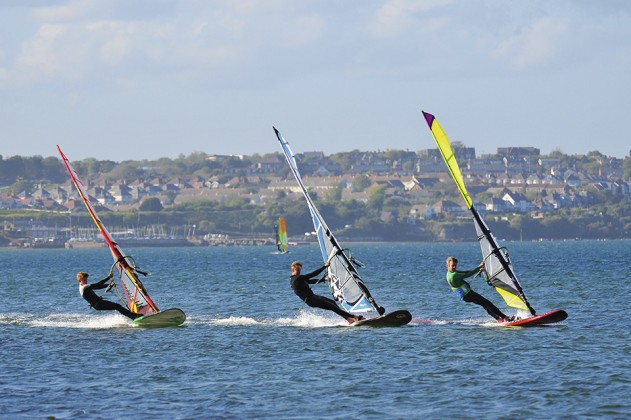THE WINGS OF A DOVE – 7.5M CAMMED SAIL TEST 2015
Test Editor Tris Best // Second Testers MAURIN ROTTENWALTER, JOE NORTH
Photos ANDY STALLMAN // Test Location OTC, PORTLAND
The camber inducer has been around, in one form or another, for a long period in windsurfing’s history. The idea of creating a deeper, more pronounced profile in the sail’s leading edge was identified early on in the sport’s timeline as beneficial to both bottom end power and top end stability, thereby extending the sail’s wind range beyond that of its rotational sibling.
This test was originally published in the July 2015 issue.
Indeed, right up until the mid-nineties, it was generally perceived that camber inducers were a prerequisite in sails of around 5.7-6.0m and above. The advances in technology on the world tour were filtering directly down to the recreational market and everyone was trying to keep up, convinced that putting more inducers into a sail would help improve performance. There were even brands pushing seven battened sails that had an inducer at the end of every batten! Only the die hard manoeuvre-oriented windsurfers, such as wave sailors, remained unconvinced. To them, the forced profile of cams resulted in heavy cumbersome sails that were hard to rig, impossible to de-power and uncompromising in their rotation. And many could see their point. After all, who said that what happened on the world tour was the right thing for the recreational market? A revolt was afoot…
In 1997 a new sail concept burst onto the scene that changed the windsurfing industry for good. The Naish Noa was championed by windsurfing legend Robby Naish as the next best thing for the sport. It was a seven battened, no-cam sail that surpassed previously unstable camless sails by use of stiffer battens and modern shaping techniques. Marketed as possessing the stability of a cammed sail whilst retaining the manoeuvrability of a wave sail, it was an instant hit and triggered a tremendous rush of new camless freeride sails that rightly dominate the recreational market still today. So what of the camber inducer? Has it become solely the domain of the amateur and professional racer?
FINDINGS
On test here we have a broad cross-section of what is available on the market for 2015. There are some twin cams with narrow luff sleeves; a twin cam with a deep sleeve, several 3-cam sails and even a sail that is pitched as an interchangeable 2/3 cam contender. What is clear from using this diverse array of powerhouses however, is that the advances in the sport’s top echelons of competition, still resonate in this group. Whether it be lighter materials, refined luff curves or better components, some of these sails really do have a state-of-the-art feel and look about them. And what is more, they are as far down the no-compromise slalom route that 99% of recreational sailors will need to go down to fulfill their goals on the water. But before deciding on which sail might be the right one for you, start by identifying the sort of performance you are looking for and the type of board you are likely to partner the sail with. There is quite a difference amongst the contenders here – sails that err toward light-wind performance and those that only really come alight when the wind starts to blow.
SUMMARY
This was one of the more difficult tests to complete within the set time frame, purely because the wind conditions in Portland Harbour were very much ‘all or nothing’. Either we had gale force winds … or a mill-pond! We certainly had a chance to test the top end stability and performance of these sails I can tell you! Luckily the conditions moderated in the nick of time to complete the testing, with a week of steady sea breezes thanks to the increasing air temperatures. And in this group, we really have a mixed bag of abilities as well. For light wind ease and practicality we have the Bolt, providing effortless rigging and rotation, making it the perfect introduction to the cammed sail world. There is then the Simmer 2XC with its narrow luff sleeve, offering the best balance of both light wind power and top end stability, without becoming too overbearing or heavy to use. Delving deeper into the cammed ‘freerace’ spectrum we then come to the three cams of the Attitude, North Sails and RRD, each of which bestows incredible stability with some form of adaptability. The North can shed a cam to become lighter and easier in the hands; the RRD can gain one to increase its race pedigree. And the Attitude offers stunning value for money when you consider its wind range and build. That leaves us with the Phantom by GA-Sails. Quite clearly the most expensive sail in the group, it only houses two cams, but provides such a fantastic performance range that it would undoubtedly leave the 6-7 cammed sails of old lulling in its wake. Cammed sails will always have a place in the market and thanks to the constant development done by the sport’s leading brands, we, the consumer, can enjoy the benefits of cams without being lumbered with their shortcomings.
THE OTC
This test was conducted at the Official Test Centre (OTC) at Portland, Dorset. The OTC centre is based within the grounds of the National Sailing Academy that hosted the Olympic sailing classes in 2012. With the best wind stats on the south coast, mirror flat water in prevailing winds and a safe launch area with excellent facilities, it provides the ideal test venue. Much of the kit is still on site, so why not go and try some of it for yourself?
THE LINE-UP


